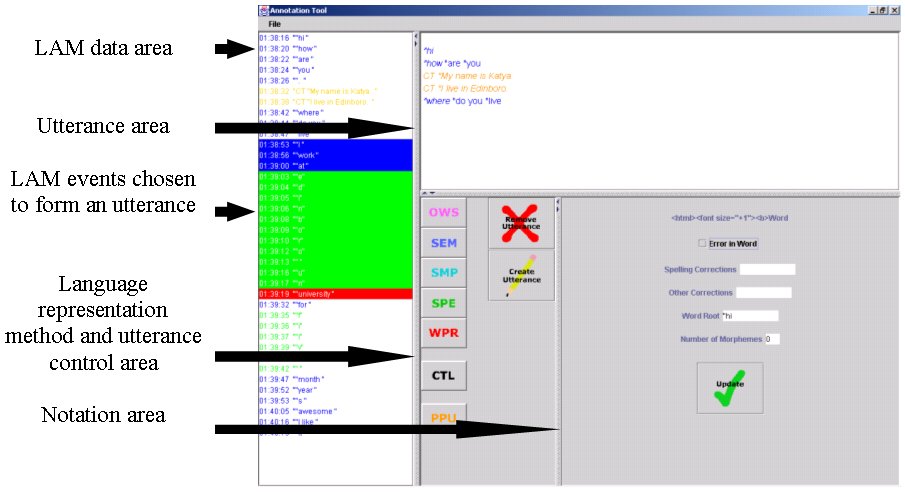AAC PERFORMANCE REPORT TOOL (PERT)
ABSTRACT
Augmentative and alternative communication (AAC) evidence-based clinical practice requires the collection and analysis of language samples. The language activity monitor (LAM) is now a standard feature of modern high performance AAC systems and facilitates the collection of language samples. An AAC Performance Report has been created to guide AAC therapy, but the generation of that report has been a time-consuming manual process. This paper describes the development of Performance Report Tool (PeRT), software to facilitate the creation of the AAC Performance Report from LAM data. The impact has been the increased use of evidence at the personal level by professionals providing AAC therapy.
BACKGROUND
The life experience of people with significant communication disability who rely on AAC is closely related to their ability to communicate. Speech-language pathologists (SLPs) and other AAC professionals provide services with the goal of optimizing communication performance. The American Speech-Language-Hearing Association (ASHA) Scope of Practice defines the profession of speech-language pathology in the United States (1). The Scope of Practice articulates that SLPs provide services "in accordance with the principles of evidence-based practice" (EBP). A major component of AAC EBP is the measurement of communication performance. This may be done through the collection and analysis of language samples.
Prior to the development of language activity monitoring (LAM) (2), language sample collection was a burdensome task requiring the audio recording and subsequent transcription of communication. Even then, time information was generally unavailable. The LAM function records both the content and the time of language events generated using an AAC system. It is available in three forms: as a built-in feature in many AAC systems, as software for a PC, and as an external add-on device. The following is an example of the LAM record of the events leading up to a single utterance: "It's faster than spelling everything out which is what I used to do "
The time stamp has a resolution of one second. Following the time stamp is an optional three letter mnemonic that defines the source of the event in the AAC system. Between quotes is the content of the event. A typical language sample would consist of a set of such utterances generated either in the natural environment or during a clinical procedure such as an interview, picture description, etc.
STATEMENT OF PROBLEM
A set of communication performance summary measures of clinical value has been identified (3). The procedures for determining the sixteen summary measures have been defined. Several measures can be generated using Systematic Analysis of Language Transcripts (SALT) (4), but SALT requires manual generation and coding of the transcript. Other measures can be generated using ACQUA (Augmentative Communication Quantitative Analysis) program (5). Most measures can be generated using a standard spreadsheet program after studying how each measure is defined. However, the process of extracting the summary measures from LAM data using multiple tools and methods has been so labor intensive that only the most dedicated of AAC professionals have undertaken to pursue frequent performance measurement for their clients.
What was needed was a method of facilitating the conversion of LAM data into an AAC Performance Report. The method needed to be simple enough to allow use following a short introduction, yet effective enough to yield meaningful and useful results.
METHOD
The College of Wooster offers computer science students the opportunity to participate in the Applied Mathematics Research Experience (AMRE). Through AMRE small teams of students, supervised by a faculty advisor, work on a project for an eight-week period in the summer. The AAC Institute contracted with the AMRE program for the development of PeRT.
The AMRE team started with a definition of the need provided by the AAC Institute, a not-for-profit charitable organization dedicated to the most effective communication for people who rely on AAC. The team chose Java as the programming environment for two primary reasons. Java programs can be designed to be platform-independent, allowing the program to be run on both PC and Macintosh computers. As an object-oriented language, Java has many building blocks available so that programming can be done quickly.
 |
RESULTS
The PeRT screen (Figure 1) has four areas. To begin use of PeRT, a previously saved LAM data text file is opened. If the data does not include the optional mnemonic identifying the language representation method (LRM), a default method can be chosen. The LAM data appears in the area on the left of the screen, color-coded according to the language representation method. The indicated LRM can be overridden at this point. The AAC Performance Report has two primary sections: utterance-based summary measures and word-based summary measures. The first step in analyzing a language sample is to segment the sample into utterances. Each utterance is highlighted by placing the cursor on the first event of the utterance in the LAM data area and dragging down to the last event of the utterance. Then the CREATE UTTERANCE button is clicked and the utterance appears in the utterance area of the screen. Various notations (errors, bound morphemes, etc.) can be made relative to both words and utterances.
Upon completion of the utterance segmentation process and entering the information on the subject, the AAC system, and the language sample collection procedure, the AAC Performance Report can be automatically generated.
DISCUSSION
PeRT is being used by AAC professionals to support evidence-based clinical practice. They are reporting that PeRT is easy to learn to use and that their frequency of language sample collection and analysis has increased significantly. Feedback is being gathered and enhancements are being planned. PeRT is contributing to the shift toward AAC evidence-based clinical practice.
REFERENCES
ACKNOWLEDGMENTS
Initial work on AAC performance measurement was supports by grants awarded to Prentke Romich Company by the National Institute for Deafness and other Communication Disorders of NIH. Research was coordinated at Edinboro University of Pennsylvania.
CONTACT
Barry
Romich
AAC Institute
Email: bromich@aacinstitute.org
http://www.aacinstitute.org
